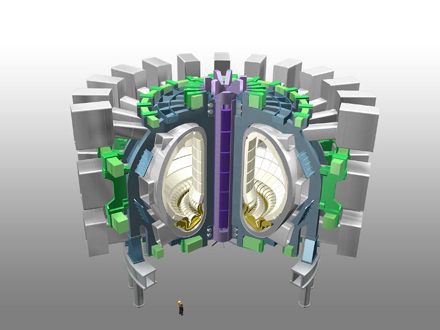Nuclear fusion becomes economic reality?

Nuclear Fusion mimics the reactions that occur in the sun to create safe, clean nuclear energy. Sound like hot air? Not according to a leading US venture capitalist who believes it will become economically viable within several years.
"Within five years, large companies will start to think about building fusion reactors," Wal Van Lierop, CEO of Chrysalix Energy Venture Capital, said in an interview at the Clean Tech Investor Summit taking place in California this week.
Van Lierop's prediction isn't futurism; currently the US is involved in a project to build a large scale fusion reactor. Van Lierop is also one of the earliest and more active investors in clean tech: Chrysalix started investing in clean energy in 2001. The firm's limited partners include BASF, Shell, and Rabobank.
Nuclear fusion is the opposite of nuclear fission; it brings atoms together to form heavier elements, rather than breaking them apart to form lighter elements -- the fission process. Nuclear fusion is the reaction responsible for producing energy in the sun.
Chrysalix's optimism is pinned on an angel investment the company made in General Fusion, a Canadian company that says its ultimate plan is to build small fusion reactors that can produce around 100 megawatts of power. The company claims plants would cost around US$50 million, allowing them to generate electricity at about four cents per kilowatt hour. This would make fusion power competitive with conventional electricity, which had long been a hurdle for the experimental technology.
Other firms, such as Venrock, have invested in nuclear fusion, but most avoid it. Lierop claims this is because generally the technology is not well understood.
"I want to see it succeed, not only because I would make a lot of money, but because it would solve many of our problems," he said.
Nuclear fusion is also politically volatile because people associate it with nuclear weapons, even though nuclear fusion plants cannot be used to make them. Another myth about nuclear fusion is that it does not produce nuclear waste -- it does -- although the mass of highly toxic nuclear waste it produces is substantially smaller than the waste produced by fission reactors.
Nuclear fusion has been studied for decades, but has never been commercialised due to the impracticality of replicating the solar reactions in a controlled environment. Currently, there is an international effort to build economically viable nuclear fusion reactors, the ITER. The ITER partners include the world's economic heavyweights: the US, China, the EU, Russia, India, Japan and South Korea.
Chrysalix Energy Venture Capital, along with the ITER use a fusion technique called Magnetised Target Fusion (MTF). This technique involves trapping plasma -- super heated gas -- in an extremely powerful magnetic field. Fusion reactors built around this principal are known as the "Tokamak" design.

The Tokamak fusion reactor design, based around trapping plasma in a magnetic coil.
Credit: ITER
Within this magnetic field, two isotopes of hydrogen, tritium (atomic mass three) and deuterium (atomic mass two), are heated to around 100 million degrees Celsius. Tritium and deuterium fuse together to form Helium (atomic mass four), and a neutron (atomic mass one). At this temperature, the plasma gas would vaporise any material known, another reason why it is necessary to suspend the gas in a magnetic field.
While expensive, both the tritium and deuterium forms of hydrogen are common commodities. Hydrogen is the most abundant material in the universe, and deuterium can be purified from sea water while tritium is formed from nuclear decay of lithium-6, another common element.
The net result is a form of nuclear power that is much cleaner and safer than conventional nuclear power. It also relies on a much more abundant fuel source than the uranium used by fission reactors. Fusion reactors are also much safer than conventional nuclear reactors, because once the magnetic field fails the reactor cools rather than heats, preventing uncontrolled nuclear reactions.
However, due to the neutrons produced by the process, the reactor material eventually becomes radioactive -- producing hazardous nuclear waste.
Fusion power has long been an area of scientific interest; however Cold War politics impeded the necessary collaboration for serious research. The end of the Cold War allowed for much more co-operation between superpowers and both the US and Russia became part of the ITER at its formation in 1985.
Since then research into fusion power has proceeded at a frantic pace, and rising power costs associated with greenhouse gas emissions have made the technology increasingly viable. Several working experimental reactors exist around the world, including the US DIII-D, the Chinese EAST, the Japanese JT 60, the Russian T-15 and finally the largest of all, the JET based in the UK.
Currently, ITER is working on an international joint project to construct the largest yet fusion reactor in the world, the ITER reactor. The reactor is expected to begin operating in 2016.
News.com's Michael Kanellos contributed to this story.